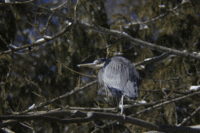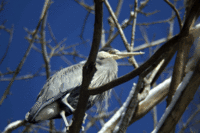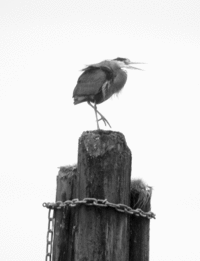Ardea herodias
From marinelife1011
| Great Blue Heron | |
|---|---|
 |
|
| Scientific classification | |
| Kingdom: | Animalia |
| Phylum: | Chordata |
| Class: | Aves |
| Order: | Ciconiiformes |
| Family: | Ardeidae |
| Genus: | Ardea |
| Species: | heroidas |
| Binomial name | |
| Ardea herodias Linnaeus, 1758 |
|
The familiar Ardea herodias, or the Great Blue Heron, is a large wading bird found in the heron family, Ardeidae. It is the largest, and most widespread heron of North America, and one of about sixty heron species worldwide [1]. It can be found in a variety of freshwater wetlands, as well as estuaries and seacoasts.
Contents |
Description
Morphology
Average Size: Length: 46" Wing Span: 72" Weight 5.3 Lbs [2]
A. herodias is unmistakable, one of the most identifiable birds in North America. It is the largest of all North American herons with an average wingspan of six feet. The forehead as well as the majority of the crown are white with a line of black that continues backwards over the eyes, terminating at the occipital plumes. The rest of the head is white apart from a bluish-black spot of plumage near the base of the bill. The sides and back of neck are have a rust color. The front of the neck is striated longitudinally with rust, black, and white. Overall, a bluish gray, apart from a distinct black shoulder patch and a small cinnamon colored patch, which is sometimes concealed by the wing. The breast and underside are black, and the legs an orange-yellow color, as well as the bill.
A. herodias shows very little sexual dimorphism, however on average females are up to 10% smaller than males. [1]
Juveniles, although similar to mature individuals, lack body plumes and have a darker bill.
Phylogeny
Ardea herodias is in the order circoniiformes (wading birds), and the family Areidae, which includes herons, egrets, and bitterns. Originally the group was divided into two sub-families, the bitterns and all other species. [3] Currently the group is divided into four subfamilies is most accepted. Even with genetic testing, there is still much debate over the taxonomic arrangement of herons. The number of subspecies is unclear, but currently it is accepted that there are between four and eight. The Great White Heron, A. h occidentalis of Florida is an entirely white morph which often breeds with A. h herodias creating the intermediate Würdemann’s Heron in the Florida Keys. There is also a non-migratory population in the Pacific Northwest, A.h. Fannini. [4]
Call
Although generally silent, the great blue heron's call can be described as a gruff, croaking 'fraannk'.
Similar Species
- Tricolored Heron (Egretta tricolor): More slender, as well as having a striking white underside and chest, and occipital plumes in contrast to the Great Blue Heron's black.
- Little Blue Heron (Egretta caerulea): Similar to juvenile A. herodias, However, is is smaller and has a dark blue-gray bill, and dark greenish legs.
- Great Egret (Egretta thula): Could be mistaken for the white morph of A. herodias. However, it is smaller, and more slender overall, lacks occipital plumes, and has black legs.
Behavior
Diet
A. herodias hunts by standing very still and stalking before stabbing its prey. Their long neck and bill enable them to forage in aquatic habitats. It is a carnivore, and is known to eat a variety of foods such as: Voles, snakes, bull frogs, crustaceans, fish, other birds, and even pilferage domestic animal's food. [4]
Reproduction
Breeding takes place once a year, usually in large stands. Monogamous pairs are formed for the season. Breeding occurs in groups called "heronries", as opposed to "rookeries", which is reserved for other types of gregarious birds such as rooks. Nesting areas can range from a few to five hundred nests in some cases. In Northern ranges breeding occurs from March to May, and November to April in Southern. Clutches range from two to seven eggs, and have a gestation period that lasts an average of twenty seven days. [5]
Heron chicks are born altricial and nidiculous. Food is fed to the young through regurgitation, which includes the participation of both parents. Chicks leave the nest when they are able to maintain their body temperature independently, which is usually from sixty-one to eighty days. Herons reach sexual maturity at around twenty-two months. [1]
Ecology and Distribution
Geographic Range
Great Blue Herons can be found through out the entire United States. Their range continues well into Canada, as well as wintering populations in Mexico continuing to the most northern tip of South America. There are also populations on the Galapagos Islands, Cuba, and Jamaica.
Habitat
Habitats of the Great Blue Heron include a variety of wetlands, such as: streams, lakes, ponds, swamps, rivers, and is equally at home on seacoasts and estuarine environments. [5]They are even known to feed in dry agricultural fields from time to time. [4]
Conservation
Conservation Status: Least Concern
Great Blue Herons were not hunted as voraciously, and seemingly haven't been as affected as other herons. Their numbers remain strong, however loss of habitat and chemical run off are an increasing threat.
References
- ↑ 1.0 1.1 1.2 Butler, R.W.1997.The Great Blue Heron.UBC Press.
- ↑ Sibley, D.A.2003.The Sibley Field Guide to Birds of Western North America.Alfred A. Knopf.
- ↑ Sibley, D.A.2001.The Sibley Field Guide to Bird Life & Behavior.Alfred A. Knopf.
- ↑ 4.0 4.1 4.2 Soothill, Eric and Richard.1982.Wading Birds of the World.Blanford Press.
- ↑ 5.0 5.1 Essinger,A.M. 2007. Great Blue Herons in Puget Sound. Puget Sound Nearshore Partnership Report No. 2007-06. Published by Seattle District, U.S. Army Corps of Engineers, Seattle, Washington.
External Links
The Cornell Lab of Ornithology
Acknowledgments
Photos by A. Oelsner
Illustration by Suzy W.






